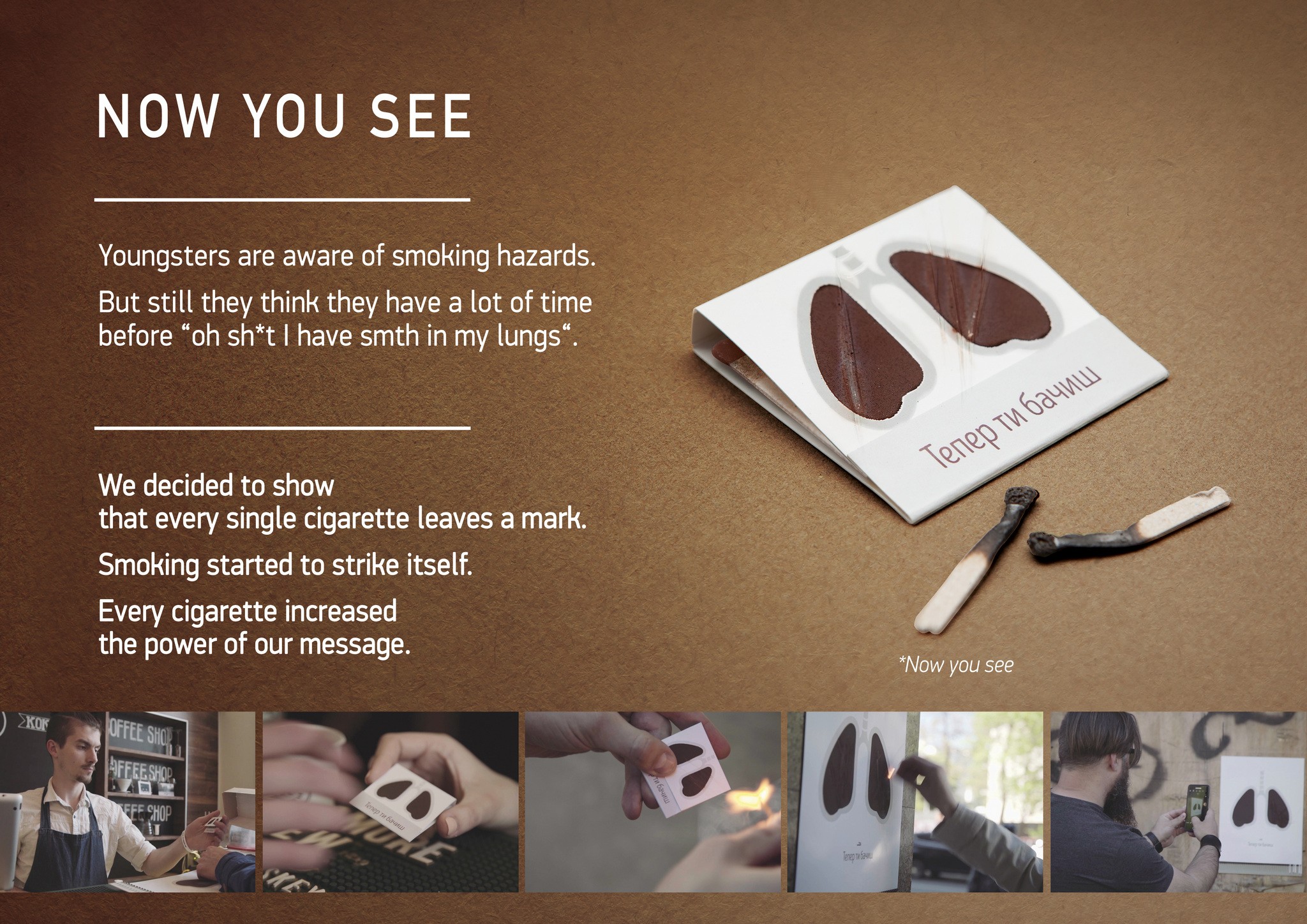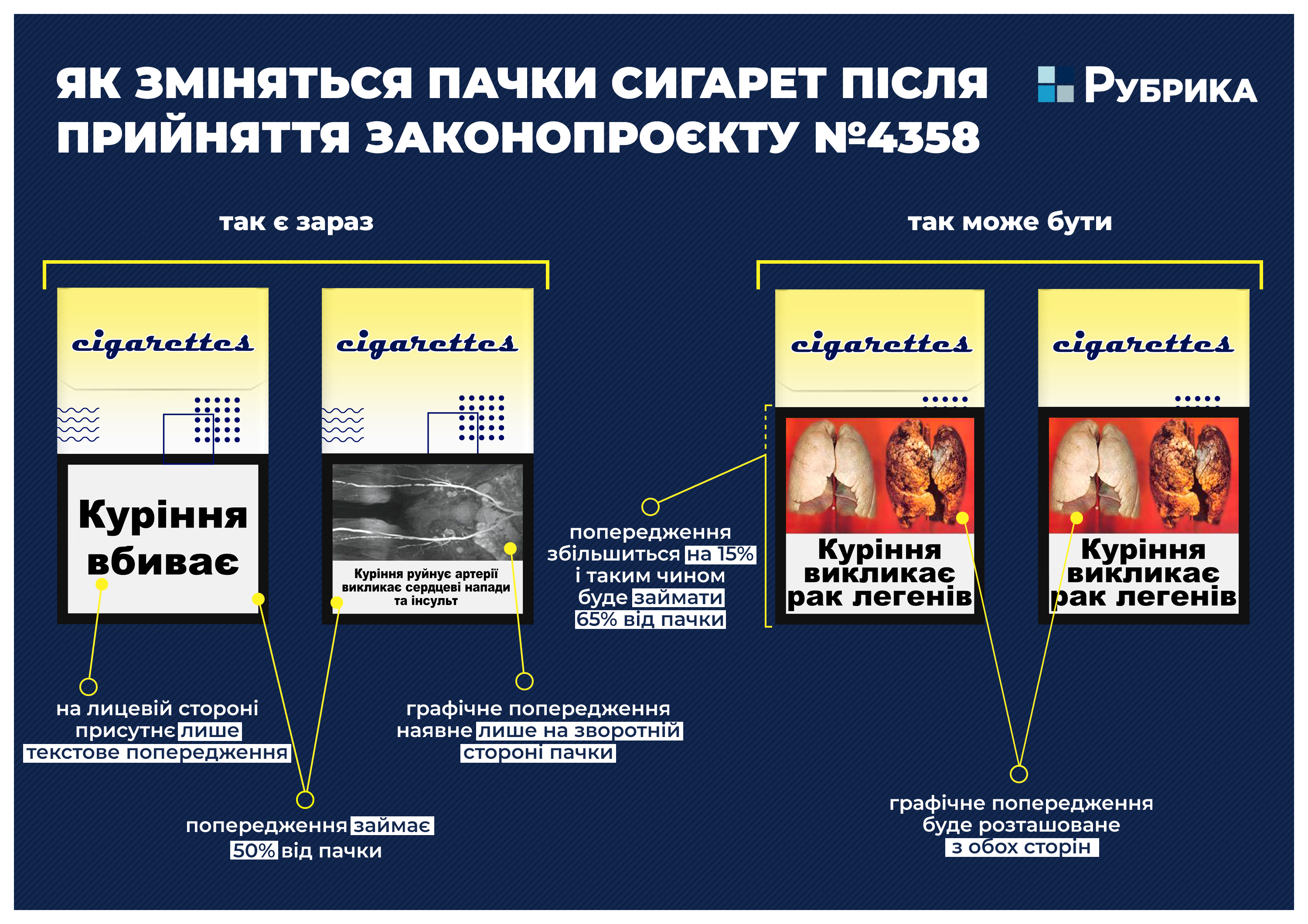
2012. Ukraine introduces a total ban on all types of tobacco advertising. It seems to disappear from billboards and TVs and stops multiplying the wealth of tobacco producers for a while. But a decade later, in 2021, indirect advertising models have already been established, loopholes in the law allow heated tobacco products (HTPs) to be openly advertised, and the industry is thriving again. Meanwhile, there are very few social campaigns against smoking.
Rubryka explains how tobacco companies bypass laws, create a new image and increase influence on public policy.

Coffee shops, lungs, and slowing down laws
Kyiv. Several people pass around matches in miniature boxes with a lung-shaped ignition area in local coffee shops. You light a match and leave a mark on your lungs. They are handed out to bartenders with an offer to give to people who ask for a smoke. And posters with the same surface are hung at the entrances to the same cafes and on the street.
Smokers get closer and look. Cigarette, match, scratching, leaving a trace. The lungs gradually disappear.
This was the social anti-advertising of smoking, which was developed by the "Agama" creative agency in 2016. The project was called "Now You See" and launched "matches that help to quit smoking." The number was limited. A gift with meaning for the person whose health you want to take care of.
"We thought that real social projects can sometimes belong to everyone. This time we decided to make society a customer… We found a way to show clearly that every cigarette smoked leaves its mark, and launched a campaign with matches and posters where the ignition area was shaped like lungs.
So, smoking began to attack itself. Each cigarette increased the strength of our message about the dangers of smoking," said the advertisers.
Meanwhile, tobacco manufacturers have increased their influence on public policy. According to the WHO, in 2017-2018, the tobacco industry did its best to slow down government projects to control tobacco products. This lasted until 2021, and only now deputies approved a comprehensive anti-tobacco draft law №4358 in the first reading, which, if approved, will ban the advertising of not only cigarettes but also HTPs and other electronic smoking devices. At present, such products aren't registered as classic tobacco products despite the direct use of tobacco.
Probable new regulations will also prohibit selling these to minors, smoking tobacco heating devices in public spaces, and selling cigarettes with different flavors. In short, the draft law is intended to definitively identify electronic smoking devices with tobacco products.



But the key role can be played by the ban on advertising because it creates the image of caring producers and socially responsible businesses for tobacco market players. Today, manufacturers of electronic smoking devices easily broadcast the message that it's fashionable and safe. But how exactly do they do it?
A turnkey reputation and concerned business image
"Messages that these companies care about the health of their customers are present in their communication across the line. But all audiences, both smokers and non-smokers, know it's not the case," said Dartsia Kaplia, PR Group Head at SPN Agency.
Thanks to a state-run anti-smoking campaign launched in 2006, the image of tobacco companies has been severely damaged. It was then that Ukraine ratified the WHO Framework Convention on Tobacco Control. Thus, companies were banned from advertising tobacco products and sponsoring large-scale public events, where the patrons' identities were hung everywhere and the names of companies were repeated.
According to the Global Adult Tobacco Survey, it has paid off, and compared to 2010, in 2017, the overall prevalence of smoking decreased from 28.3% to 22.8%. However, cigarette manufacturers have also begun to look for alternative approaches and seem to have successfully found them.
"Tobacco companies are trying to reach new audiences. And these new audiences are approached with different positioning. For example, the "Philip Morris" company. It's a huge tobacco company, but it positions its IQOS product not as a tobacco product, but as a gadget. Fashionable gadget. And here the company communicates and builds its reputation in a completely different way.
There are entertainment events, festivals, and film screenings… The brand conducts fan entertainment communication and thus earns the reputation of a youthful innovative company. They update their image.
And to 'clear' the reputation and change it, you must first change the product. It's impossible to do this without a product," Dartsia Kaplia comments.
Philip Morris is a subsidiary of an American company whose Ukrainian office is one of the largest players in the local tobacco market. The company is actively promoting its new product, the IQOS tobacco heating system. And it does it in a non-standard way for a tobacco company by calling to quit smoking.
Drop one thing and do another
IQOS is positioned as an alternative to smoking, which can be addictive, but dramatically reduces the harm from tobacco. However, last year's WHO study has already refuted the IQOS message about safe smoking; the heating aerosol contains more than 50 carcinogenic components. And e-cigarettes contain toxic substances: metals (chromium, nickel, lead), carbonyls (formaldehyde, acetaldehyde, acrolein, glyoxal), harmful flavors (diacetyl, cinnamaldehyde, benzaldehyde).
Still, the advertising campaign for the devices continues. Bloggers receive gifts from Philip Morris and film so-called unboxing, collecting thousands of views. IQOS appears on billboards, in influencers' stories, and places of honor in shop windows. So, according to the manufacturers, IQOS is already among the gadgets of more than a million young people in the country, which clearly shows that it's fashionable, so it won't be easy for the state health policy to convince the audience about the harm of devices.
But Philip Morris' strategy isn't just about outdoor advertising and collaboration with thought leaders. They also win this title for themselves. The company invites students and graduates to internships, promising attractive career opportunities, and also gets involved in charity, violating current legislation and donating money not directly, but through charitable foundations.
For example, Philip Morris donated UAH 10 million to fight coronavirus in Ukraine. In total, the corporation has donated $30 million worldwide to counter COVID-19. But such actions aren't useless.
At the same time as the charity, the company doesn't inform its customers that smokers with COVID-19 have a higher risk of complications in the form of pneumonia. Instead, the brand establishes cooperation with the "Glovo" delivery network, creates an entire campaign with "quarantine gifts," lowers prices, distributes souvenirs, and thus increases sales.

Directly to profits, by turns of corkscrew between laws
In 2012, since the start of a total ban on tobacco advertising, Ukrainian companies have stopped outdoor advertising of cigarettes. But in early 2019, numerous billboards appeared on the streets of Kyiv with smiling young people and the slogan: "One for everyone."
That's how Vynnyky Tobacco Factory decided to promote its Marvel tobacco brand. The company launched water production: corporate colors, logo, name, and slogan completely duplicated the cigarettes of the same name. The water bottle on the billboards was depicted in the lower right corner in a way that it was difficult to see it.
"I can't read the thoughts of the brand's marketers, but it seems to me that it was an attempt to creatively circumvent the law banning tobacco advertising. I never saw Marvel water on the shelves. So it seems that it was an image advertising of the brand and they just advertised themselves," says expert Dartsia Kaplia.
Marvel water could really be found infrequently on store shelves. But at the same time, posters duplicating billboards have appeared in the windows of cigarette kiosks and other stores; the same smiling young people, the same short slogan.
Subsequently, after complaints to the State Food and Consumer Service, the billboards were removed, and no other tobacco company dared to repeat this PR move.


To love with eyes and suffer with lungs
Even though tobacco advertising is banned almost all over the world, except for a few countries, $23 million is spent every day on tobacco marketing campaigns, according to the WHO. What are the sums for, if the usual advertising is prohibited?
Unfortunately, it's impossible to find out about the marketing costs of Ukrainian cigarette manufacturers. Under national law, such information is a trade secret, and any attempt to obtain it is treated as interference in economic activities.
But, most likely, the only available platform for companies to showcase their brand is street furniture, kiosks, shops and it costs a lot of money.


In 2017, experts from the Kyiv School of Economics conducted a study that showed that bright cigarette displays in shop windows push young people to smoke. As a rule, the most attractive thing for potential smokers are special boxes or panels, the layout of which is decorated in bright colors, and the product itself is highlighted.
Also, the cashiers often have large models of real brands, which is little different from outdoor advertising. Kiosks decorated in this way are often located near schools, which promotes the development of adolescent and children's smoking. Children and adolescents who see the bright windows of street furniture with cigarettes are 60% more likely to become smokers.
Draft law №4358, which may soon be adopted by deputies in the second reading, from the beginning was called to regulate the visual issue, banning the layout of cigarettes in shop windows. This item was later removed, but according to a study by the Kyiv International Institute of Sociology, the decision to ban advertising tobacco products is supported by 87% of Ukrainians.
In addition, now a mandatory requirement for the cigarette pack design is a warning about the dangers of smoking with the appropriate images. The warnings occupy 50% of the design. Meanwhile, the authors of the draft law proposed to increase this area to 65%.
Working in anonymity conditions
Besides producers and consumers, there's another side to the advertising of tobacco brands, namely advertising agencies, which undertake the development of PR strategies and seek ways to promote products for smokers.
We can regard such work in the advertising industry as a task with an asterisk. According to the advertisers themselves, cooperation with the tobacco business has its subtleties and is mostly not entirely transparent.
Tatiana has been advertising for about six years and has witnessed the main image transformations of successful tobacco brands. The woman says that for agencies, talking publicly about work on advertising campaigns for tobacco producers means risking their reputation. That's why she refused to give her last name and place of work at all. But she decided to talk about cooperation schemes between PR and tobacco producers.
"Tobacco companies pay a lot of attention to their promotion. Accordingly, advertising agencies receive a lot of orders. But it's not accepted to publicize it. If the agency agrees to work with the cigarette manufacturer, not always, but in many cases, the agreements include a separate clause stating that the company will not disclose who prepared the advertisement. It's not so much a question of honesty as a question of security of one's reputation," Tetiana explains.
The woman justifies this logic simply: no one wants problems with the law and other customers. If you make an advertising campaign so that it's successful, you'll have to use hidden advertising and play "with a hidden agenda."
"Some agencies working to promote e-cigarettes and smoking gadgets have openly stated such cooperation. Because now such products haven't yet equaled in terms of legislation with conventional cigarettes. But this may change, so many people are reinsured now," Tetiana adds.
The woman says that she agrees with the position of anti-tobacco activists that since customers of tobacco companies are dying fast, they're looking for new consumers, even among minors. The advertiser admits that this phenomenon is frustrating, but it exists and that many campaigns are aimed at attracting young people and adolescents.
"Bright colors, accurate slogans, creating an atmosphere of a kind of fun atmosphere… It's all aimed mainly at young people. If you want to sell cigarettes to teenagers, you have to make the product adult and childish at the same time. Most young audiences emphasize that tobacco products have different tastes and smells. This allows teenagers to do conditionally adult things while remaining children," says the advertiser.

"But we just know it"
As for the state health policy, Tetiana believes it is first necessary to enshrine new rules in law, and then apply a creative approach to advertising.
The PR specialist says that as long as the law leaves loopholes, such as window dressing, indirect advertising, and the opportunity to do charity work through fictitious people, but with full-fledged PR, the state will also lose in communications. And its citizens will suffer from it.
Meanwhile, Dartsia Kaplia, PR Group Head "SPN Agency," immediately talks about social advertising and that it lacks imagery:
"Everything that concerns human health is always a person's choice. Should the state intervene in these issues? Probably so. But not by propaganda or simple phrases like 'smoking kills,' but by creativity and explaining.
We all know that a drop of nicotine kills a horse, smoking is a high risk of cancer, and so on. But we just know it. Most of those who haven't encountered this have no living examples, and photos of lung cancer don't affect so much.
The state and those who are conducting an anti-tobacco campaign need figurative and very vivid examples that will emotionally engage the audience. Where it will recognize itself, friends, relatives. This communication should be quite imaginative and evoke a lasting emotional connection. Then it will be effective.
We see that smoking kills on cigarette packs, but does the smoker stop? No," says Dartsia.
Everyone has heard the warnings about lung cancer, infertility, and addiction, but there are still many who aren't affected.
The school curriculum includes topics about the dangers of smoking, generations of schoolchildren have prepared posters and various educational projects about the damage caused by tobacco to the body. But as smoking advertising improves, so can anti-advertising.
Several countries are implementing policies to radically combat smoking and are setting deadlines for minimizing the problem. This is the approach that experts consider the most effective.














